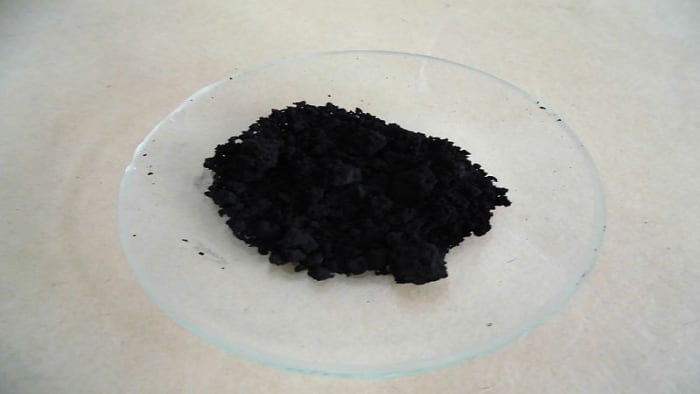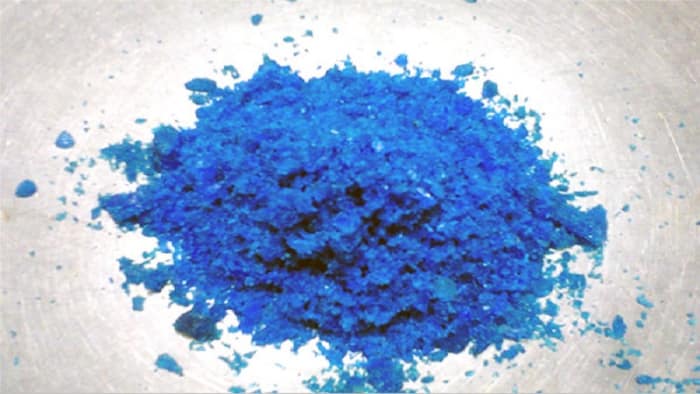Reaction between copper sulfate and iron
What can you see when iron reacts with copper sulfate?

Iron is an element of the eighth group of the fourth period in the Periodic Table. It is a malleable silvery metal with good electroconductivity and pronounced magnetic properties. In nature iron is mainly encountered in an oxidized state – for example brown iron ore Fe₂O₃·3H₂O, red iron ore Fe₂O₃ (hematite), pyrite FeS₂, magnetic iron ore Fe₃O₄.
Obtaining iron and its reaction with simple substances

Metallic iron is obtained in industry by reducing it from iron oxide with carbon monoxide CO:
- Obtaining carbon (IV) oxide from coal:
C + O₂ = CO₂;
- Obtaining carbon II oxide (reducer for obtaining iron):
CO₂ + C = 2CO;
- Reduction of iron from iron oxide:
Fe₂O₃ + 3CO = 2Fe + 3CO₂.
Iron can also be obtained directly by reducing it with hydrogen at a temperature of 1000 ᵒC (1832 ᵒF):
Fe₂O₃ + 3H₂ = 2Fe + 3H₂O.
Chemically pure iron is obtained by electrolysis of the solution of its salt:
K(-): 1) 2H₂O + 2e = H₂ + 2OH⁻;
- Fe²⁺ + 2e = Fe(0).
A(+): 2H₂O - 4e = O₂ + 4H⁺.
Summarily:
FeSO₄ + 2H₂O = Fe + H₂ + O₂ + H₂SO₄.
With non-metals, iron reacts at high temperatures:
-
3Fe + 2O₂ = Fe₃O₄ (a mixture of iron (II) and (III) oxides form);
-
Fe + S = FeS;
-
2Fe + 3Br₂ = 2FeBr₃.

Reactions of iron with complex substances
At a temperature of 700 ᵒC (1292 ᵒF), iron reacts with benzol with the formation of iron carbide:
18Fe + C₆H₆ = 6Fe₃C + 3H₂.
At room temperature in air and in the presence of moisture, iron corrodes (corrosion is the spontaneous disintegration of metal under the impact of the environment):
4Fe + 3O₂ + 6H₂O = 4Fe(OH)₃ (reaction takes place rather slowly in normal conditions).

When iron is fused with an alkali in the presence of nitrate, ferrates form on the cation of the alkali:
Fe + 3NaNO₃ + 2NaOH = Na₂FeO₄ + 3NaNO₂ + H₂O.
Click here for exciting experiments with iron.
Iron enters into a displacement reaction readily (reactions in which atoms or groups of atoms of the same initial substance replace atoms or groups of atoms of another initial substance – for example according to the scheme АВ + С = АС + В). With diluted acids, iron reacts with the formation of iron (II) salt and hydrogen:
Fe + 2HCl = FeCl₂ + H₂.
Concentrated nitric acid (and concentrated cold sulfuric acid) passivates iron, and this reaction does not take place. With concentrated hot sulfuric acid and diluted nitric acid, acid reacts as follows:
-
Fe + 6H₂SO₄ = Fe₂(SO₄)₃ + 3SO₂ + 6H₂O (only with heating);
-
Fe + 4HNO₃ = Fe(NO₃)₃ + NO + 2H₂O.
With salts, iron may also enter into a displacement reaction. Between copper (II) sulfate and metallic iron, the following reaction takes place (an example of a typical displacement reaction between inorganic substances):
Fe + CuSO₄ = FeSO₄ + Cu (iron displaces copper in the salt solution; the iron dissolves, turning into solution, and metallic copper of a reddish color is released).

The reaction does not take place in this way with all salts – displacement is only possible if the displacing metal is more reactive than the displaced one. As iron is to the left of copper in the reactivity series (is reactivity in the series decreases from left to right), we may say that iron is a more active metal than copper. This is why it displaces copper from copper salt solution.
We may observe some visual effects when carrying out this reaction. CuSO₄ (“copper sulfate” or copper (II) sulfate) is a salt with a bluish color. When a silvery iron bar is put in a copper sulfate solution, the solution slowly starts to change color – the bright blue color gradually turns green (the salt FeSO₄ which forms in replacement has a green color). Metallic copper of a reddish color also starts to form around the dissolving iron bar. As the copper in this reaction has a rather loose structure, it may separate from the iron bar and precipitate.
The reaction between copper sulfate and iron is oxidation-reduction: iron is oxidized and copper is reduced:
Fe + CuSO₄ = FeSO₄ + Cu;
There are two processes:
-
Cu²⁺ + 2e = Cu⁰ (reduction process, Cu²⁺ is the oxidizer);
-
Fe⁰ – 2e = Fe²⁺ (oxidation process, Fe⁰ is the reducer).
Metallic copper is often used for the manufacture of pipes, wires and power cables. Copper alloys are also often used in practice – for example, bronze (copper and tin), brass (copper and zinc) and duralumin (copper and aluminum).
Iron has found an application in practically all branches of industry – iron salts are used as catalysts in organic synthesis (for example FeCl₃), to purifying water and manufacturer iron alloys – for example cast iron and various steels (both types of alloys contain iron and carbon in different ratios).